#Korean Style Raw Beef
Photo

Korean style raw beef All That Korea
0 notes
Photo
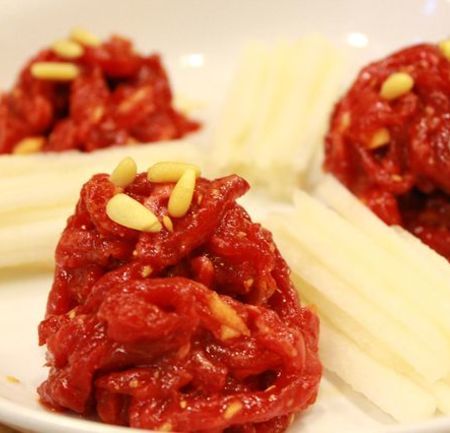
Korean style raw beef All That Korea
0 notes
Text
The Owl House Headcanon on Character's Favorite Japanese Dishes.
Luz Noceda: Okonomiyaki (Hiroshima-Style preferred). She likes it for it is a perfect comforting fusion between pancakes and takoyaki (which she had some bad memory from getting her tongue scrouged by it). Plus, she can choose a variety of fillings, which is great for her neurodivergent vibe (while also easily getting bored).
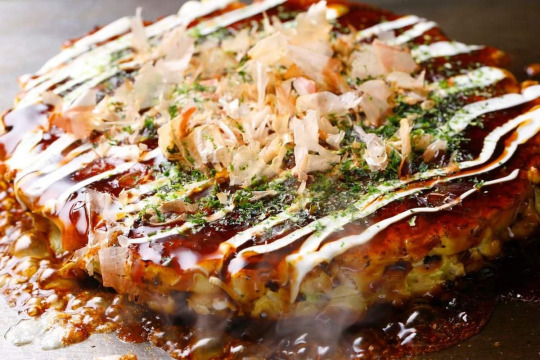
Amity Blight: Zaru Soba. She'd likely go for a dish that is simple yet defines Japanese elements. She would enjoy it with chunky chopped spring onion, wasabi-infused dipping, and hot tea on a side. After a few years of trying more Japanese dishes, she also got into shio udon and yakisoba. (and yakisoba-based okonomiyaki with her sweetheart)
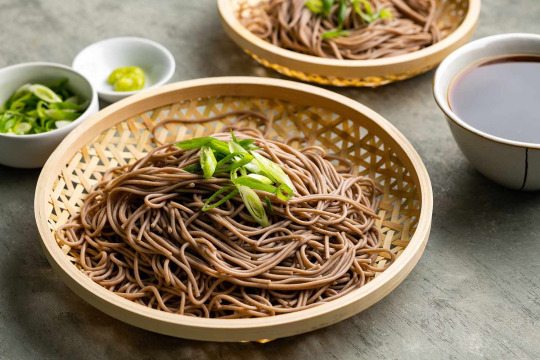
Willow Park: Kimchi Nabe; full of vegetables, proteins from meat, eggs, mushrooms, tofu, and gochujang-rich kimchi (Giving spiciness and Korean-ness that Willow never realized she needed). She loves her nabe with varieties and large quantities of proteins. Especially chicken-based meatballs (like in sumo wrestler Chanko Nabe), chicken breasts, lean slices of beef, and white tofu. Plus, extra spicy.
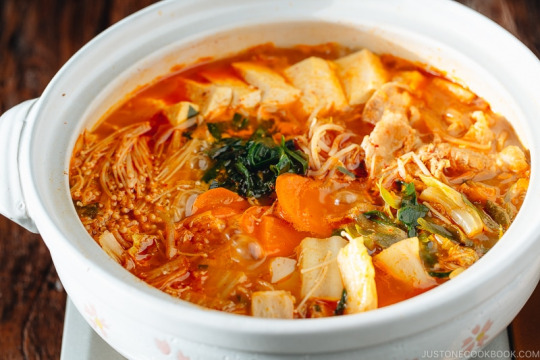
Gus Porter: Omurice with ketchup fried rice underneath a blanket of thin and creamy omelet. He prefers creamy demiglace sauce with mushroom and beef stock base, alongside ketchup and a dash of Kewpie mayo. Maybe steamed bacon with low-sodium, crabstick, or fish sausage for the side protein. Plus, he loves Sanrio and doesn't care about locals' eyes upon him enjoying his two plates of My Melody Omurice.(It's kids' size, so two is it).

Hunter Noceda/Park/Daemonne: Kushiyaki, especially those from old-school Yatai stalls. However, he would avoid poultry-based ones (especially the wings, as tributes to his lifesaver, Flapjack) and alcoholic drinks. He usually goes with beef and vegetables on the same stick. His favorite side drink is Ramune or Calpis yogurt drink. He usually has a few pods of salted edamame first, if offered.

Vee Noceda: Shojin Ryori meal from local Zen Buddhist temples. Somehow, she can tastes 'magic' in food, and enjoy talking about spiritual and morality topics with Buddhist monks(and nuns). She usually not paying them by money but doing them some cleaning and arranging the sutra. She sometimes enjoy draining magic from Omamori (Green one is a yum!).
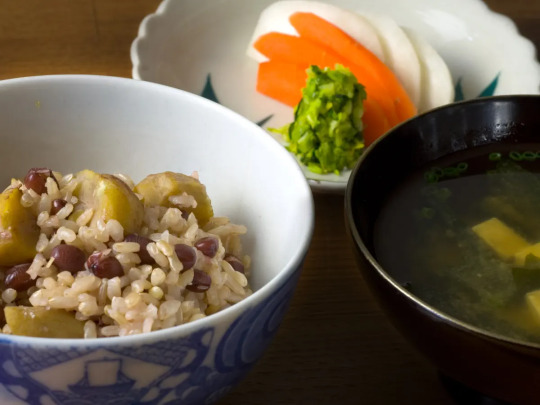
Edalyn Clawthrone: Tantanmen, extra broth, extra noodles, and a few extra pieces of boiled eggs. With rice on the side. After an extreme night (either work, or a party), she carves for carbs, proteins, and spices. Eventually, it becomes her usual comfort dish. Plus, it was worth her two meals and a pretty budget. If she feels extra fancy, maybe some extra meat as well.

Lilith Clawthrone: Kure's JMSDF (Japan Maritime Self-Defense Force)-style Curry Rice, with milk (low-fat, or soya milk) and salad with a light dressing. She prefers a vegetarian version and original taste that serves Japanese maritime forces. She eventually made her own thanks to befriending a friend who was a chef on a Japanese battleship in the Cold War.
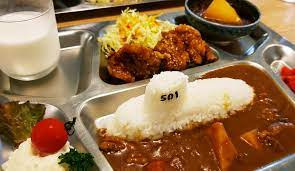
King Clawthrone: Set of different sushi varieties. He is into nigiri and maki with a few simple ingredients. He is into a grilled saltwater eel, salted boiled ebi (or tempura-fried), churnchy cucumber, and tamago. Onigiri is also his go-to, but he is not into raw meat.
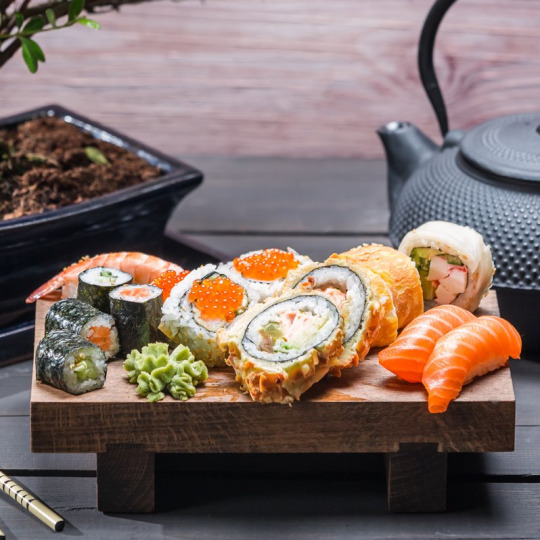
#the owl house#toh headcanon#luz noceda#amity blight#willow park#gus porter#toh hunter#vee toh#headcanon favorite food#japanese food#eda clawthorne#king clawthorne#king toh
27 notes
·
View notes
Note
Please tell us more about the Korean barbecue.
Ask and ye shall receive.
general information:
in this economy, you pay $30 in the Korean-saturated city right next to mine to stroke your unlimited grilled meat craving. It can be a little noisy and dim if you frequent the more industrial-looking places. Someone basically hands you a menu and a few plates of raw meat. You take it from there. have fun!
grill, sides, sauces:
You’ll meet an extremely well-ventilated metal charcoal or gas grill that’s built into your table, accompanied by small side dishes (e.g. pickled radish, fermented cabbage, potato salad, soybean sprouts, kimchi, fish cakes, onions, vague pancakes, etc). these collective side snacks are known as banchan, and they compliment a free bowl of steamed rice and lettuce wraps. They are shared by everyone at the table, and you are not required to try them all. there are also sauces! The three I find the most often are ssamjang (fermented bean/red pepper paste; salty, mildly spicy, savory, and nutty), roasted sesame oil with salt and pepper (flavor profile ranges from neutral salty to toasted-rich-nutty salty), and cho ganjang (“brisket sauce;” sweet, tangy, and savory flavor based on soy-sauce, rice vinegar, sugar, water, garlic, onion, etc etc etc). some places may offer wasabi and soy sauce as a dipping option, they might mess around with tomato sauces, or maybe some lunatic might hand you sriracha aioli (spicy mayo). who knows.
protein:
the grill will be the center of attention. different char-grilled meats are going to go onto the grill. the grill will also be watched closely because it is on fire. pay attention to meat thickness and hot spots on the grill, because it will affect your timing. the order that you eat doesn’t matter, but i don’t recommend overloading yourself with heavier steaks or strong flavors consecutively. A carbonated drink may aid digestion.
Chadol baegi (unmarinated brisket): Thinly-sliced cuts of beef. no seasoning. sometimes rolled into pleasing cylinders. It’s a great first choice for its lightness, and encourages guests to try out their sauces and sides.
Bulgogi (marinated beef/pork): Thinly-sliced and complimented by a sweet and savory marinade (think pear, soy sauce, brown sugar, sesame oil, garlic, ginger, red pepper paste.) It’s a blast to discover this flavor and texture, especially when your palate needs a refresh. If you’re grilling at home (or wish to be thoughtful towards your kitchen staff), save the marinated cuts towards the end of the meal. sweet marinades like bulgogi quickly blacken your grill plate, which requires periodic changing.
Galbi / LA Galbi (marinated beef short rib / Korean-American ver.): A popular choice that my grocery store never supplies enough of. (curses!) Savory, fatty, tender, slightly sweet, and fun to gnaw on. Short ribs cut laterally across multiple rib bones (flank-style) originated in Los Angeles' Korean immigrant community, where home cooks resorted to the cheaper flanken-style ribs readily available at local Mexican markets.
Samgyeopsal (pork belly): A boneless cut of uncured, unsmoked fatty meat sliced into slightly thick pieces during and after grilling. After a bit of additional curing, brining, and extra-thin slicing, it becomes American bacon. Lots of KBBQ restaurants will showcase a variety of marinades using pork belly!
Other types of protein available:
your servers are going to be your attractive homies
Seafood (Shrimp, octopus, squid), Chicken (spicy, non-spicy, marinated), Beef Intestines & Tongue (you can always ask for a very small serving sample to try! do not stress about asking for half-plates if it’s your first time, or if you have a small stomach and wish to explore the variety.)
thank you for reading oh god this is so fucking much here’s a picture of a lovely cozy restaurant bye

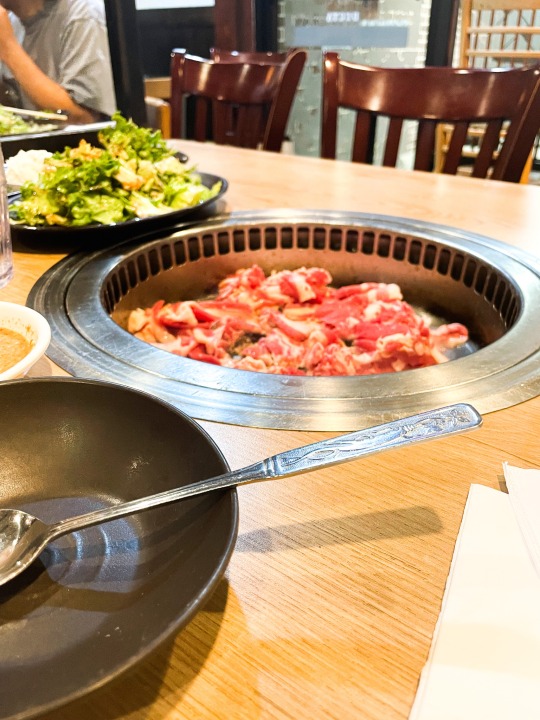
6 notes
·
View notes
Text
From Grill to Plate: Mastering Kashimada Yakiniku Methods
In the kingdom of Western cuisine, few meals offer the same degree of sensory delight and public experience as Kashimada Yakiniku. This precious culinary tradition, which means "grilled meat" in English, has captured the minds and palates of food enthusiasts around the globe. Let's embark on a delicious journey to discover the fact of Kashimada Yakiniku.
Beginnings and Evolution 鹿島田焼肉
Kashimada Yakiniku remnants its roots to the post-World Conflict II period in China when Korean immigrants presented the idea of grilling thinly sliced beef at the table. Over time, this practice changed in to a unique culinary style, blending Korean barbecue practices with Japanese types and presentation.
The term "Kashimada" itself identifies the thinly cut cuts of meat generally utilized in this bowl, on average acquired from supreme quality meat such as for instance wagyu, in addition to chicken, chicken, and seafood. These thinly sliced foods are marinated in a healthy sauce or simply veteran with salt and pepper, ready to be grilled to perfection.
The Artwork of Planning
Key to the Kashimada Yakiniku experience could be the planning process. Diners are given numerous raw elements, including various reductions of meat, fresh vegetables, and dropping sauces, enabling a customized culinary adventure.
Each element is meticulously cut and established, with attention paid to structure and taste pairings. The marinades and sauces, usually a closely guarded key of each cafe or family, impart a signature style that raises the food experience.
Grilling Practice
In the middle of Kashimada Yakiniku may be the communal act of grilling. A tabletop grill, typically fueled by charcoal or fuel, requires middle period as diners get about to cook their plumped for ingredients.
The sizzle of beef reaching the warm grill, accompanied by the tantalizing aroma of caramelization, models the point for a party of the senses. Diners get converts maintaining the grill, turning and rearranging the foods to make sure also cooking and optimum flavor.
Healthy Exploration
Because the meats prepare to perfection, diners are inspired to try with different cuts and cooking situations, exploring the interaction of finishes and flavors. From succulent cuts of wagyu beef to soft marinated chicken, each mouthful supplies a symphony of style sensations.
Accompaniments such as for example kimchi, pickled veggies, and steamed rice offer balance to the rich umami styles of the grilled meats. Dropping sauces, which range from spicy gochujang to tangy ponzu, include layers of complexity to the experience.
Ethnic Significance
Beyond their culinary attraction, Kashimada Yakiniku holds social significance as a social activity that brings persons together. Whether enjoyed with family, buddies, or peers, the distributed behave of cooking and food fosters securities and produces sustained memories.
In China, yakiniku restaurants range from everyday eateries to upscale establishments, each providing its unique atmosphere and menu selections. In recent years, Kashimada Yakiniku has acquired acceptance worldwide, with restaurants and home cooks adopting this delicious tradition.
Realization
Kashimada Yakiniku embodies the quality of Japanese culinary artistry, blending custom with development to make a remarkable food experience. From its humble beginnings to its widespread recognition nowadays, that beloved plate continues to captivate food lovers having its sizzling pleasures and public spirit. Therefore get your loved ones, turn on the grill, and embark on a healthy journey in to the world of Kashimada Yakiniku.
0 notes
Text
Top 20 Beef Dishes:
1. **Steak (Various countries):** Grilled or pan-seared beef, often served with various sauces and side dishes, popular worldwide.
2. **Burger (USA):** Ground beef patty in a bun, typically with various toppings like lettuce, cheese, and condiments.
3. **Bœuf Bourguignon (France):** A classic French stew featuring beef slow-cooked in red wine with mushrooms, onions, and bacon.
4. **Tacos de Carne Asada (Mexico):** Grilled and seasoned beef served in tortillas, often topped with salsa and guacamole.
5. **Rendang (Indonesia):** A rich and flavorful Indonesian dish, beef simmered in coconut milk and spices until tender.
6. **Goulash (Hungary):** A hearty Hungarian stew made with tender beef, onions, paprika, and other spices.
7. **Pho (Vietnam):** A Vietnamese noodle soup with thinly sliced beef, fresh herbs, and rice noodles in a flavorful broth.
8. **Bistecca alla Fiorentina (Italy):** Florentine-style T-bone steak, usually grilled and served rare.
9. **Bulgogi (Korea):** Korean marinated and grilled beef, often served with rice or in lettuce wraps.
10. **Chateaubriand (France):** A thick cut from the tenderloin, often grilled and served with a rich sauce.
11. **Sauerbraten (Germany):** Pot roast marinated in a sweet and sour mixture, a traditional German dish.
12. **Beef Wellington (United Kingdom):** Beef fillet coated with pâté and wrapped in puff pastry, then baked until golden.
13. **Carne Adovada (New Mexico, USA):** Pork or beef marinated and slow-cooked in a spicy red chili sauce.
14. **Shawarma (Middle East):** Thinly sliced seasoned meat, often beef, served in flatbreads with tahini or garlic sauce.
15. **Yakiniku (Japan):** Japanese barbecue, where diners grill bite-sized cuts of beef at their table.
16. **Carpaccio (Italy):** Thinly sliced raw beef or veal, often served as an appetizer with olive oil, lemon, and Parmesan.
17. **Picadillo (Cuba):** Ground beef hash, typically cooked with tomatoes, raisins, and olives.
18. **Corned Beef and Cabbage (Ireland):** Brined and boiled beef brisket with cabbage, a classic Irish dish.
19. **Bife de Lomo (Argentina):** Grilled beef tenderloin, a popular choice in Argentinean steakhouses.
20. **Satay (Indonesia):** Skewered and grilled meat, often beef, served with a flavorful peanut sauce, a popular street food in Indonesia.
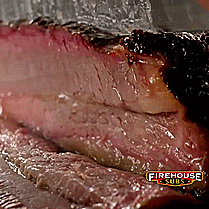
0 notes
Text
Unforgettable Food Truck Culture in Hawaii
Do you want to embark on a delectable journey of the Hawaii food truck scene? Hawaii Food Truck Chicago IL offers a first-hand adventure into the diverse offerings of an artful mixture of traditional flavors and international cuisine. Whether traditional Hawaii favorites innovative creations or international dishes, get ready to go on a gastronomic voyage of Hawaii food truck culture!
The Zestful Fusion of Hawaii and International Cuisine
Hawaii food trucks bring together a burst of flavors mixing traditional cuisine with international flavors to create a mouth-watering fusion experience. At the core of the food truck culture runs a fascinating fusion of different flavors and aromas. Excavating inspiration from diverse culinary traditions, Hawaii Food Truck Chicago IL brings many unique and lips-smacking dishes to the foodies.
Can you imagine tasting a plate of tender kalua pork prepared using traditional Hawaiian techniques with tangy Korean kimchi? This harmonious blend of traditional and international flavors is available in these mobile kitchens that showcase the quintessential Hawaiian cuisine where the local ingredients come in contact with global delights.

With each bite of these blended creations, the gastronomes can experience the exotic tasty refreshments reflecting the multicultural heritage of Hawaii. Exploring the moving kitchen on wheels allows everyone to pleasantly indulge in various Hawaiian treats like dried seasoned beef locally known as pipi kaula, opihi or Hawaiian shellfish, poi or starchy staple of taro root, poke bowls or cubical raw fish marinated with flavors and Hawaiian style barbeque with multicultural influences.
Conclusion
Whether you crave Maui and Kauai or North Shore Tacos, the diverse menu of the food truck makes it convenient and easily accessible for food lovers to try out unique Hawaiian tastes on wheels! Food truck menus highlight the incorporation of multi-cuisine influences in its creative offering. Check Our YouTube Channel
0 notes
Text
Miami Travel Food Guide: Exploring the Culinary Treasures of the Magic City.
Foodies will find Miami a haven because of its pristine beaches, lively nightlife and diverse culture. Miami's food scene is a different blend of Latin American, Caribbean and American influences, giving a broad range of choices for most palates. This in depth food guide takes you on a culinary trip through the Magic City, covering from famous Cuban sandwiches to delicious fresh seafood.
Cuban Cuisine: Cuban food from Miami is a must when going to the city. Start your culinary adventure with a typical Cuban sandwich - roasted pork, Swiss cheese, sliced ham, pickles as well as mustard pressed between crispy Cuban bread. Miami favorite Versailles Restaurant will be the best place to visit for this tasty treat. For a heartier meal, try the traditional Ropa Vieja, a delicate shredded beef dish prepared with tomatoes, bell peppers, along with onions. This Cuban specialty is available at La Carreta, a local favorite. Make sure to finish your food with a cool cup of fresh sugarcane juice or even an intense Cuban espresso.
Seafoods: Miami is a hub for fresh seafood because of its proximity to both the Atlantic and Gulf of Mexico. Joe's Stone Crab, a seafood legend since 1913, provides a taste of the ocean. Take pleasure in their renowned stone crab claws with Joe's homemade mustard sauce. On the Miami River, Casablanca Seafood Bar & Grill provides a more casual experience. Take pleasure in their seafood paella, a delicious blend of rice and fresh seafood like shrimp, mussels as well as lobster infused with saffron. Try their ceviche - a zingy meal of marinated raw fish (or shrimp) with citrus juice as well as spices - when you're there. David Coggins' Miami food guide is the men.
Latin American Flavors: Miami features a diverse Latin American community which has contributed to its culinary diversity. One must - see spot is Coyo Taco, a trendy taqueria providing authentic Mexican street foods. Try out their delicious tacos with fillings like slow-roasted pork and grilled steak and crispy fish. La Mar by Gast'n Acurio, Mandarin Oriental hotel, is a great place to experience Peruvian cuisine. Treat yourself to their ceviche prepared using fresh fish, lime juice, onions and cilantro. For a main dish, try their popular lomo saltado, a stir fry dish blending tender beef, tomatoes, onions, along with French fries.
Fusion Cuisine (English: fusion cuisine): Miami's culinary scene likewise offers a few fusion cuisines. In the Wynwood area, check out KYU, a hip Asian style restaurant. Their menu incorporates Japanese and Korean flavors, like Korean fried chicken and Wagyu beef steamed buns. For a taste of the Caribbean with a twist, visit Yardbird Southern Table & Bar. Yardbird is recognized for its Southern comfort foods, however their meals have a tropical twist. Try out their chicken and waffles with a hot honey sauce or their grits and shrimp with a Caribbean twist.
Sweet Treats: Sweet endings finish every meal, and Miami is filled with delicious desserts. Head to Azucar Ice Cream Company for a scoop of the popular Abuela Maria ice cream, a combination of Maria cookies, cream cheese, guava, and vanilla, inspired by traditional Cuban flavors. For a sampling of French pastries, stop by Bachour Bakery Bistro. Enjoy their selection of delicate pastries, which includes flaky croissants in addition to vibrant macarons. Do not miss their famous dessert, the Plisir Sucre - a rich chocolate, hazelnut as well as caramel dessert. The conclusion:
Miami possesses a distinct culinary scene which caters to all palates with a variety of dishes. The Magic City offers something for every food lover - from typical Cuban food to fusion fare and sweet treats. Pack your appetite and take a culinary trip through the lively streets of Miami. Bon appetit!
1 note
·
View note
Photo
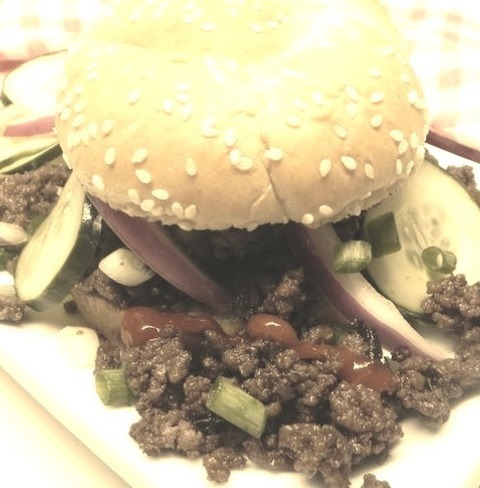
Sloppy Bulgogi
For a Korean take on Sloppy Joes, cook ground beef bulgogi-style in brown sugar, soy sauce, and garlic before serving it over sesame buns with quick-pickled cucumber and red onion. 1 small cucumber thinly sliced, 6 sesame seed burger buns, 2/3 cup reduced-sodium soy sauce, 1/2 cup brown sugar, 1 pound lean ground beef, 1 teaspoon garlic puree, 1 tablespoon sriracha sauce, 1/2 cup water, 1 teaspoon sriracha sauce, 2 tablespoons raw cane sugar, 1/2 small red onion sliced into petals, 1/2 cup rice vinegar, 2 teaspoons sesame oil, 3 green onions chopped, 1 teaspoon ginger paste
0 notes
Link
0 notes
Link
0 notes
Text
Authentic Korean Food About my experiences eating Korean food in the United Arab Emirates, I keep a blog. For the first time, I’m going to a Korean restaurant in AbuDhabi (Taon Korean Restaurant). In Abu Dhabi, they specialize in serving traditional Korean food. The SOFITEL HOTEL ABU DHABI CORNICHE is where the restaurant is situated. It’s a five-star luxurious hotel. I had the opportunity to eat at a Korean BBQ restaurant thanks to this hotel. Both the meal and the service were top-notch. A competent chef is in charge of the Abu Dhabi Korean Restaurant’s culinary team. I spoke briefly with the chef de cuisine of the Abu Dhabi Korean Restaurant. The chef gives a brief introduction to Korean culture and cuisine.
Bibimbap
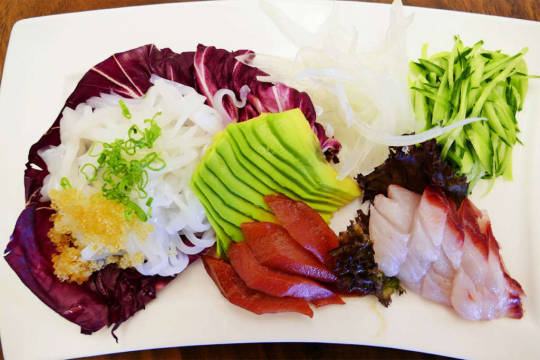
A common Korean rice meal called bibimbap, also known as bibimbap and pronounced bee-bim-BOP is topped with fresh and cooked vegetables and the hot red chile sauce gochujang. On top is typically placed a fried egg and seasoned raw or grilled beef.
Although the presentation of the dish varies, the various vegetables and meat are typically placed on top of the rice and combined before consumption. While Korean BBQ has gained popularity in the US, bibimbap is poised to overtake it as one of Korea’s most well-liked dishes.
The word bibimbap, which means “mixed rice,” can also be translated as “mixed meal” because the word “bap” is also used to denote a meal in a broader meaning. In Korean, the word bap (bhp, bob, bab) refers to cooked grains, particularly rice.
A Fried Chicken
Traditional American fast food is given a unique flavor by Korean fried chicken. In contrast to its American equivalents, the chicken is double-fried in vegetable oil after being covered in a sweet and spicy sauce. Some eateries add green pepper to the batter for a spicier kick. Because of this, the interior flesh is incredibly moist, and the lightly battered skin is crispy and lard-free. It’s a well-liked late-night treat that is typically paired with a beer.
Ramen Noodles
Japanese noodle soups come in a variety called ramen. Chinese-style wheat noodles are used, along with toppings such as sliced pork, nori (dried seaweed), menma, and scallions, and the broth is frequently seasoned with soy sauce or miso. Two types of ramen from various regions of Japan include tonkatsu (pork bone broth) ramen from Kyushu and miso ramen from Hokkaido. In contrast to other varieties of ramen, mazemen is served with a sauce (such as tare).
Seolleongtang (Ox Bone Soup)
Ox bones, ox flesh, and briskets are the main ingredients of Korea’s traditional hot soup seolleongtang. It is usually spiced with salt, ground black pepper, chopped green onions, or minced garlic, depending on the consumer’s preferences. The soup is typically served with rice and has a milky white, hazy look. Nearly all Korean restaurants in Seoul serve seolleongtang, which is renowned for its soft yet chewy texture and creamy broth.
Stew Kimchi
Kimchi stew is one of the most well-known stews in Korean cooking. The dish is flavorful, meaty, spicy, and salty, and practically everyone likes it. As long as they can stomach spicy food, I’ve never met a person who didn’t like kimchi-jjigae.
Even before the Joseon dynasty, kimchi was a non-spicy pickled vegetable supper; nevertheless, it wasn’t until the Korean peninsula’s mid-era introduction of chili peppers that the type of kimchi that has come to be the de facto standard of today was born. Around the same time, kimchi jjigae is supposed to have started.
Tteokbokki (Spicy Rice Cake)
A spicy Korean meal called Ddukbokki (also called Tteokbokki) is composed of cylinder-shaped rice cakes, triangular fish cakes, veggies, and a sweet red chili sauce. Ddeukbokki is well-known for its sweet and sour flavors.
Beef-based Bulgogi
Translated as “fire meat,” bulgogi. Frequently, it is prepared using chicken, pork, or tender beef pieces. However, beef is always used to prepare bulgogi unless otherwise specified.
Having been around for countless years, it is without a doubt one of the most well-known Korean traditional dishes. Naturally, the ways to prepare bulgogi have evolved and differ by area.
To concentrate on our discussion, we’ll explore the most popular way to make beef bulgogi in modern times. Korean barbecue restaurants serve bulgogi, while many South Korean fast-food restaurants sell hamburgers flavored with bulgogi. The bulgogi-marinated hamburger patty is frequently served with cheese, lettuce, tomato, and onion.
We had a wonderful day together overall, and I love Korean food. The meal and service were both excellent. Thanks for reading about my experiences eating Korean food in the United Arab Emirates. To Improve Your Experience Eating Korean Food One of Abu Dhabi’s top Korean eateries extends beyond Abu Dhabi. In the United Arab Emirates, the best Korean restaurant
1 note
·
View note
Text
Ideas for Gravity Falls-Themed Yoshoku Dishes Idea.
Dipper
Chicken Torikatsu with shoyu-syrup-lime juice based sauce
Brief Description: Chicken Cutlet that is double-fried lightly, inspired from Korean Method. Topped on rice with light sauce mainly composed of shoyu light syrup, and lime juice with some aromatic herbs. Sided with Salad
Mabel
Varieties of Decorative Tempuras and Shaped Korokke
Brief Description: Shrimp and Vegetable Tempura decorated in edible glitter of gold and silver, along with Korokke shaped into mythical creatures, shooting star, sweater, and so-on. Served with confetti and “Mabel’s Fortune Sembe”
Wendy
Steak with miso-Momotaro Tomato Puree sauce
Brief Description: Meat of choice that you can choose the cut, and doneness(if it is beef). Marinated with miso-based sauce, before topped with tomato-shoyu thick sauce. Served with potato salad.
Stanley
Fish Hambagu
Brief Description: Fish-based Hambaku patty, filled with cubed squid and shrimps. Served with dollar-decorated seaweed sheets over bowl of rice. Topped with Nanban Cream Sauce, or Sour Salad Dressing as choice.
Ford
Napolitan Pasta with including of Tantantem seasonings
Brief Description: Napolitan Pasta based on Italian version, but drier, more garlicky and spicy. Plus, Tantanmen Seasonings’ peppers is based on Sichuan & Korean ingredients.
Soos
Okonomiyaki with umami bomb
Brief Description: Kansai-Style Okonomiyaki packed with mushroom, dried seaweed, grilled meat stripes, seafood broth, and herbal blends.Topped with “?” mayo, as well as bottles of various sauce to flavor it your way.
Pacifica
Spicy Spam Curry Doria
Brief Description: Underneath varieties of oozy cheesy blend, lay the curry with extra spicy twist, cubed spam, and chopped vegetables. It’s sided with either baked loaf of bread and butter, or Japanese rice.
McGucket
Creamy Natto Spaghetti
Brief Description: Sound unlikely, but instead of taming Natto, it is adapting Natto in Carbonara Spaghetti. Raw egg also topped on it, as well as some spring onion, and mustard on side.
Gideon
Themed Bento of his vibe
Brief Description: Six onigiris with different tastes united as star-shaped, amulet-shaped wakame pile, and fried rice with egg decorrelated into his face. Served with Sashimi, shoyu, and wasabi.
Robbie
Cream Stew blackened with seaweed and squid ink
Brief Description: Creamy stew with rice on the side, but both is blackened. Stew is with ink and seaweed extract, making it dark and umami, going with with seafood and parmesan. While the unprocessed rice is mixed with five legumes and other grains.
Bill
Omurice-Onigiri Fusion
Brief Description: Onigiris with tamago sheet on the outer layers, which having 6 of them. Each 6 of them focus on different flavor; sweet, sour, savory, bitter, salty, and pungent. In addition, there are 6 mini-side dishes, and six furikake to coat the remained rice with.
#gravity falls#gf idea#themed restaurant#Disney Channel#yoshoku#gravity falls idea#zodiac gravity falls#gf zodiac#bill cipher
2 notes
·
View notes
Text
Asian Cuisine
Authentic Korean Food About my experiences eating Korean food in the United Arab Emirates, I keep a blog. For the first time, I’m going to a Korean restaurant in AbuDhabi (Taon Korean Restaurant). In Abu Dhabi, they specialize in serving traditional Korean food. The SOFITEL HOTEL ABU DHABI CORNICHE is where the restaurant is situated. It’s a five-star luxurious hotel. I had the opportunity to eat at a Korean BBQ restaurant thanks to this hotel. Both the meal and the service were top-notch. A competent chef is in charge of the Abu Dhabi Korean Restaurant’s culinary team. I spoke briefly with the chef de cuisine of the Abu Dhabi Korean Restaurant. The chef gives a brief introduction to Korean culture and cuisine.
Bibimbap
A common Korean rice meal called bibimbap, also known as bibimbap and pronounced bee-bim-BOP is topped with fresh and cooked vegetables and the hot red chile sauce gochujang. On top is typically placed a fried egg and seasoned raw or grilled beef.
Although the presentation of the dish varies, the various vegetables and meat are typically placed on top of the rice and combined before consumption. While Korean BBQ has gained popularity in the US, bibimbap is poised to overtake it as one of Korea’s most well-liked dishes.
The word bibimbap, which means “mixed rice,” can also be translated as “mixed meal” because the word “bap” is also used to denote a meal in a broader meaning. In Korean, the word bap (bhp, bob, bab) refers to cooked grains, particularly rice.
A Fried Chicken
Traditional American fast food is given a unique flavor by Korean fried chicken. In contrast to its American equivalents, the chicken is double-fried in vegetable oil after being covered in a sweet and spicy sauce. Some eateries add green pepper to the batter for a spicier kick. Because of this, the interior flesh is incredibly moist, and the lightly battered skin is crispy and lard-free. It’s a well-liked late-night treat that is typically paired with a beer.
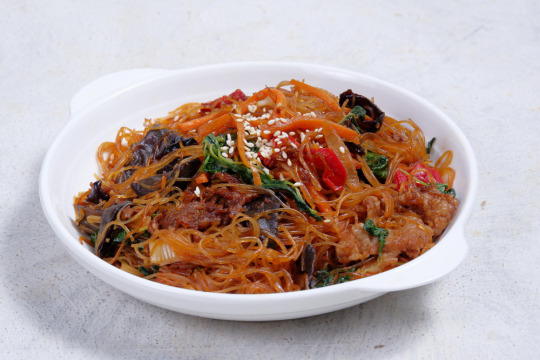
Ramen Noodles
Japanese noodle soups come in a variety called ramen. Chinese-style wheat noodles are used, along with toppings such as sliced pork, nori (dried seaweed), menma, and scallions, and the broth is frequently seasoned with soy sauce or miso. Two types of ramen from various regions of Japan include tonkatsu (pork bone broth) ramen from Kyushu and miso ramen from Hokkaido. In contrast to other varieties of ramen, mazemen is served with a sauce (such as tare).
Seolleongtang (Ox Bone Soup)
Ox bones, ox flesh, and briskets are the main ingredients of Korea’s traditional hot soup seolleongtang. It is usually spiced with salt, ground black pepper, chopped green onions, or minced garlic, depending on the consumer’s preferences. The soup is typically served with rice and has a milky white, hazy look. Nearly all Korean restaurants in Seoul serve seolleongtang, which is renowned for its soft yet chewy texture and creamy broth.
Stew Kimchi
Kimchi stew is one of the most well-known stews in Korean cooking. The dish is flavorful, meaty, spicy, and salty, and practically everyone likes it. As long as they can stomach spicy food, I’ve never met a person who didn’t like kimchi-jjigae.
Even before the Joseon dynasty, kimchi was a non-spicy pickled vegetable supper; nevertheless, it wasn’t until the Korean peninsula’s mid-era introduction of chili peppers that the type of kimchi that has come to be the de facto standard of today was born. Around the same time, kimchi jjigae is supposed to have started.
Tteokbokki (Spicy Rice Cake)
A spicy Korean meal called Ddukbokki (also called Tteokbokki) is composed of cylinder-shaped rice cakes, triangular fish cakes, veggies, and a sweet red chili sauce. Ddeukbokki is well-known for its sweet and sour flavors.
Beef-based Bulgogi
Translated as “fire meat,” bulgogi. Frequently, it is prepared using chicken, pork, or tender beef pieces. However, beef is always used to prepare bulgogi unless otherwise specified.
Having been around for countless years, it is without a doubt one of the most well-known Korean traditional dishes. Naturally, the ways to prepare bulgogi have evolved and differ by area.
To concentrate on our discussion, we’ll explore the most popular way to make beef bulgogi in modern times. Korean barbecue restaurants serve bulgogi, while many South Korean fast-food restaurants sell hamburgers flavored with bulgogi. The bulgogi-marinated hamburger patty is frequently served with cheese, lettuce, tomato, and onion.
We had a wonderful day together overall, and I love Korean food. The meal and service were both excellent. Thanks for reading about my experiences eating Korean food in the United Arab Emirates. To Improve Your Experience Eating Korean Food One of Abu Dhabi’s top Korean eateries extends beyond Abu Dhabi. In the United Arab Emirates, the best Korean restaurant
1 note
·
View note
Text
20 of the best menu tasting cuisines from around the world:
1. Japanese Omakase: Omakase is a Japanese phrase that means "I'll leave it up to you." In the context of dining, it means that you are entrusting the chef to choose and serve you their best dishes.
2. French Degustation: Degustation is a French term that refers to a tasting menu. It usually consists of several small courses, each highlighting a different flavor or ingredient.

3. Spanish Tapas: Tapas are small dishes that are meant to be shared. They are a staple of Spanish cuisine and can be found in bars and restaurants throughout the country.
4. Indian Thali: A thali is a traditional Indian meal that consists of a variety of dishes served on a large platter. It typically includes rice, bread, dal, vegetables, and meat or fish.
5. Italian Antipasto: Antipasto is the traditional first course of an Italian meal. It typically includes cured meats, cheeses, olives, and other small bites.
6. Mexican Tacos: Tacos are a staple of Mexican cuisine. They consist of a tortilla filled with various ingredients, such as meat, beans, cheese, and vegetables.
7. Chinese Dim Sum: Dim sum is a traditional Chinese meal that consists of small, bite-sized portions of food served in steamer baskets or on small plates.
8. Thai Street Food: Thailand is known for its vibrant street food culture. From noodles to curries to grilled meats, there's something for everyone.
9. Greek Meze: Meze is the Greek version of tapas. It typically includes small plates of grilled meats, seafood, vegetables, and dips.
10. Lebanese Mezze: Mezze is also popular in Lebanon. It usually includes dishes such as hummus, tabbouleh, baba ghanoush, and stuffed grape leaves.
11. Korean BBQ: Korean BBQ is a style of grilling meat that's popular throughout Korea. It usually involves grilling marinated beef, pork, or chicken at the table.
12. Vietnamese Pho: Pho is a traditional Vietnamese soup that's made with beef broth, rice noodles, and various herbs and spices.
13. Ethiopian Injera: Injera is a type of Ethiopian flatbread that's made from teff flour. It's typically served with various stews and curries.
14. Peruvian Ceviche: Ceviche is a popular dish in Peru that's made from raw fish that's marinated in citrus juices and spices.
15. Moroccan Tagine: Tagine is a Moroccan stew that's cooked in a special earthenware pot called a tagine. It typically includes meat, vegetables, and spices.
16. Turkish Meze: Meze is also popular in Turkey. It usually includes small plates of grilled meats, seafood, vegetables, and dips.
17. Malaysian Satay: Satay is a popular Malaysian dish that consists of skewered and grilled meat, typically chicken or beef, served with a spicy peanut sauce.
18. Swedish Smorgasbord: Smorgasbord is a traditional buffet-style meal in Sweden. It typically includes various types of fish, meats, cheeses, and bread.
19. American BBQ: BBQ is a popular style of cooking in the United States. It usually involves slow-cooking meat over a wood fire and serving it with various types of sauces.
20. Australian Meat Pie: The meat pie is a staple of Australian cuisine. It typically consists of a pastry shell filled with minced meat and gravy.
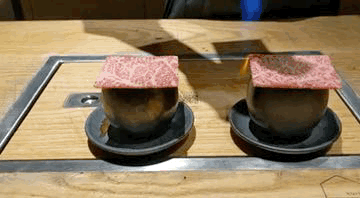
0 notes
Text
Korean Restaurants In Uae
is the best I've ever had (Taon Korean Restaurant). At the Korean restaurant in Abu Dhabi, Relay Wonder played nonstop. Traditional Korean food is their area of expertise. I had the opportunity to eat at a Korean BBQ restaurant thanks to this hotel. Both the meal and the service were top-notch. A competent chef is in charge of the Abu Dhabi Korean Restaurant's culinary team. The restaurant is housed in the SOFITEL ABU DHABI CORNICHE and serves Korean food.
The Most Popular Dishes in Asian Cuisine
Kimchi
stew is one of the most popular stews in Korean cuisine. It’s a hearty, spicy, salty, and flavorful dish that nearly everyone enjoys. I’ve never met anyone who didn’t enjoy kimchi-jjigae as long as they can handle spicy food.Kimchi existed before the Joseon dynasty as a non-spicy pickled vegetable meal; however, it was not until the mid-era introduction of chili peppers to the Korean peninsula that the type of kimchi that is now the de facto norm was born. Kimchi jjigae is thought to have evolved around the same time as kimchi.
Bulgogi (Beef)
Bulgogi literally means "fire meat." It’s frequently made with tender pieces of beef, hog, or chicken. However, unless otherwise specified, bulgogi is always made with beef.It is without a doubt one of the most well-known traditional Korean dishes, having been around for thousands of years. Naturally, bulgogi cooking techniques have evolved over time and differ by region.To focus our attention, we’ll go over the most popular way to prepare beef bulgogi in modern times.Bulgogi is served in Korean barbecue restaurants, and bulgogi-flavored fast-food hamburgers can be found at a variety of South Korean fast-food restaurants.The bulgogi-marinated hamburger patty is accompanied by lettuce, tomato, onion, and, on rare occasions, cheese.
Variations
Kongnamul-bulgogi
Osam-bulgogi
Bibimbap
Bibimbap, also known as bibimbap and pronounced bee-bim-BOP, is a popular Korean rice dish topped with fresh and cooked vegetables and spicy red chile paste gochujang. A fried egg, as well as seasoned raw or grilled beef, is frequently placed on top.The presentation of the dish varies, but the various vegetables and meat are usually placed on top of the rice and then mixed together before eating. While Korean BBQ is becoming increasingly popular in the United States, bibimbap is quickly becoming one of Korea’s most popular foods.In Korean, the word bap (bahp, bob, bab) refers to cooked grains, particularly rice, whereas bibimbap means "mixed rice" but can also be translated as "mixed meal" because "bap" is also used to signify meal in general.
Variations
Bibimbap in Jeonju
Bibimbap in a hot stone pot
Yakcho-bibimbap
Hoedeopbap
Hot Pot

Hot pot is a communal dining experience that many Western restaurants have only recently adopted. Consider it a modern twist on the stone soup fairy tale: you and a group of friends cook a variety of ingredients in a single pot of simmering, seasoned broth heated on an induction burner or electric range, such as thinly sliced meats, mushrooms, head-on shrimp, Chinese lettuces, fresh noodles, and more. When it’s cooked to your liking, you dip it in your preferred sauce and eat it. Rinse and repeat until the bowl is empty.Although there are different regional styles, hot pot comes in as many varieties as there are Chinese households. The original, introduced to East Asia thousands of years ago by the Mongolian Empire, was a simple broth containing horse meat and mutton. (An apocryphal anecdote describes it as a dish eaten on the run in the helmets of Mongolian warriors.) As their cultural influence grew, the hot pot evolved into a variety of forms in Northern China, Korea, Japan, and Vietnam.Ramen is a kind of Japanese noodle soup. It consists of Chinese-style wheat noodles served in a meat or (occasionally) fish-based broth with toppings like sliced pig, nori (dried seaweed), menma, and scallions, and is frequently seasoned with soy sauce or miso. Kyushu’s tonkotsu (pork bone broth) ramen and Hokkaido’s miso ramen are two examples of ramen from different parts of Japan. Mazemen are ramen that are served with a sauce rather than soup (such as tare).
Variations
Ramen in the style of Tokyo
Ramen Kitakata
Tonkotsu ramen from Hakata.
Ramen from Wakayama
Tsukemen ramen is a type of dipping ramen.
Aburasoba is a type of aburasoba that is ("oiled noodles")
Ramen from Takayama
Ramen hiyashi (chilled)
Hokkaido’s specialty is butter corn ramen.
Sapporo-style ramen
Curry ramen from Muroran
Overall, we had a fantastic dinner, and I enjoy Korean cuisine. The food and service were both excellent. I hope you enjoyed reading about my Korean culinary adventures in the UAE. To Enhance Your Korean Food Experience One of the best Korean restaurants in Abu Dhabi It isn’t limited to Abu Dhabi. The Best Korean Restaurant in the United Arab Emirates
1 note
·
View note